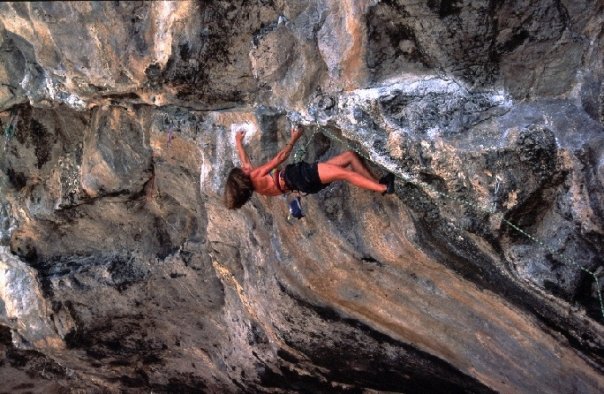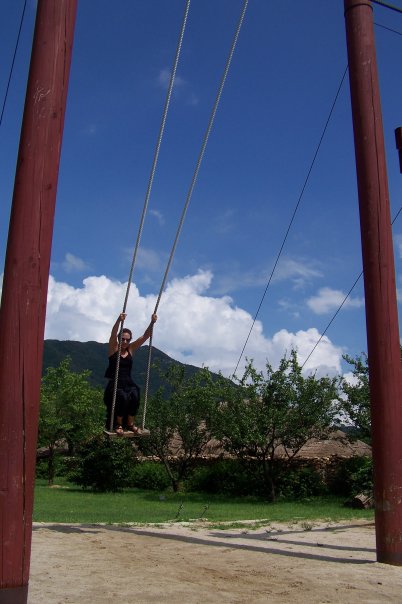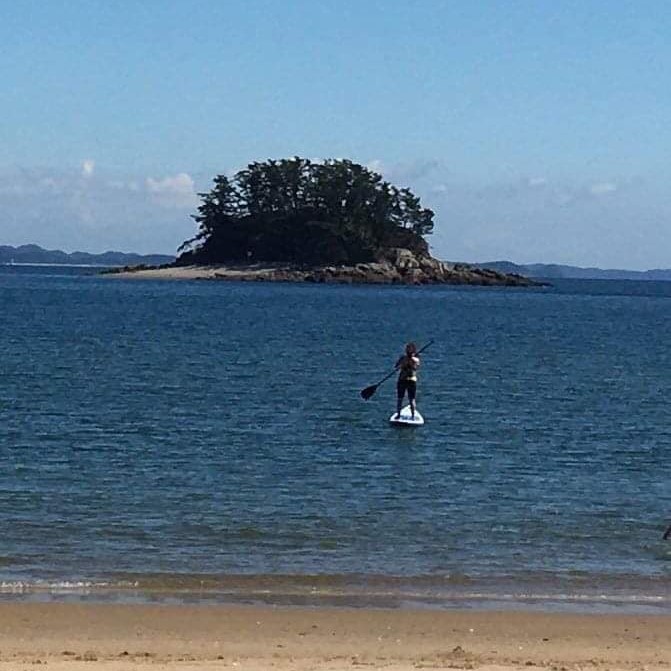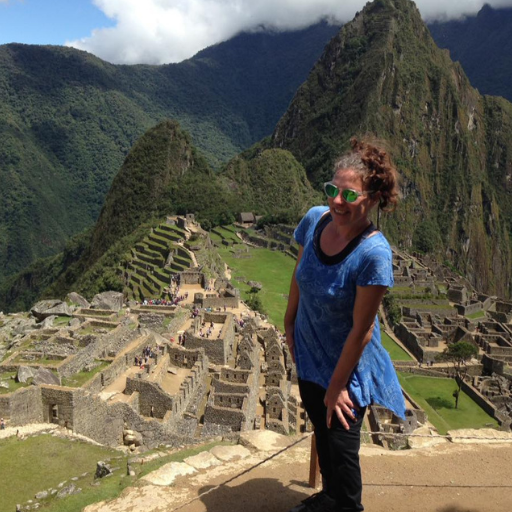A life of adventure: One year in Korea becomes a career
University English instructor Sonia Knapp thought her Korea adventure might last a year. That was more than two decades ago.
When Sonia Knapp set out for Korea in 1998, it was supposed to be short term. A New Orleans native, she was teaching at a high school in Moab, Utah, and getting tired of it. She didn’t fit in with the local community, “didn’t like living in a fishbowl,” and wanted to try something new. She thought she’d probably stay in Korea for a year.
But she’s lived here for 17 of the past 23 years. Along the way she’s spent time in Europe — she has dual citizenship with Austria through her mother — and traveled through the Middle East, India, Southeast Asia, Australia and Africa.
Sonia took some time to talk about her life and travels in a Zoom interview in March.
That first year
With a master’s degree and a teaching license, Sonia was well prepared for her Korea adventure. She also grew up traveling. But after teaching high school in the United States, teaching university in Korea brought some culture shock.
“In America, you asked the students, ‘Do you have any questions?’ and everybody asked all kinds of questions. And in America I could play devil’s advocate with students. And they’re — they’ll argue with you.”
In Korea, she recalls, most of the middle schools and high schools were segregated by gender, and that influenced interaction at the university level.
“So the class would segregate itself,” she said. “And, you know, we also had like 50 students, 60 students in a class to teach conversation. … And students didn’t talk. It was hard to get them to talk to each other in pairs, much less to you.”
There was a lot to get used to during that first year.
“Things like MT, membership training, where the students would go on trips to bond with their majors. Nobody would tell me that nobody’s going to be in class the next day, so I’d get there and be frantic, like, ‘Where’s my class? What’s wrong?’”
And the “cheat sheets” that were “stuck under every desk” — so small she didn’t know how anybody could read them. She pulled them off and showed them to her department head.
“And they would be embarrassed,” she says. The cheat sheets weren’t for Sonia’s class, because she was the only one who had the tests. “But cheating was so common back then,” she says.
Her first year was full of weird surprises. Sonia recalls “just not being aware of what you were, you know, the signs all over the apartment, water is going to be shut off tomorrow. Well, if I could prepare for it and fill up some water jugs, no problem. But you wake up in the morning, you go to brush your teeth and flush your toilet and there’s no water. It was a little shocking.”
Learning a new mindset
An avid rock climber, she made Korean friends through a rock climbing club in Seoul and even appeared in magazines as a model for climbing gear.
Her climber friends, she remembers, were “amazingly patient with me” and “super sweet.”
But again the customs were unfamiliar. She recalls a trip to the Ganhyeon Rock Climbing Park near Wonju, which is famous for its rock cliffs.
“My very first trip, I remember how excited I was to finally be climbing outside in still cold early spring … and how great I felt when I saw the cliffs. And then we put out our gear. … You put all of your gear on those silver mats. And the one thing I wasn’t expecting was people taking my stuff and using my stuff without asking me.”
She wasn’t comfortable taking other people’s things, “especially rope and gear, because you kind of want to know if it’s taken falls,” she says.
Sonia was used to sharing equipment with fellow rock climbers in the United States, but says on those trips “you don’t take things without asking. And I remember my first few hours just getting frustrated” and complaining to her friend that everyone was using her stuff.
“Sonia, use that rope,” he’d say. “Drink that Gatorade.”
“But they’re not mine!” she’d say.
“And I’m sure the whole team was thinking, like, ‘What’s wrong with Sonia? She doesn’t seem to be having a good time. She seemed so excited when we got here.’ And you know, it was a lot of just … letting go of my mindset and just realizing … when I’m in Korea, do it this way. And then I never wanted for anything, because anything on the silver mat I could just take. If I had been smart, I wouldn’t have bought anything anymore.”
As an expat, she remembers “getting over that idea of coming here and thinking everything is wrong.”
“And it’s weird, you know, 20-plus years later, I go to America now sometimes and I think, oh my God, everything here is wrong. What is wrong with these people?”
Staying calm in a crisis
Sonia decided to stay on for a second year in Korea. She remembers the date when everything changed: Feb. 1, 2000.
The accident happened on a school vacation, when she was rock climbing in Thailand. She was reaching out to make sure she could secure her rope to a bolt when “the ledge I was holding on just broke off.” Sonia didn’t hit the ground, but she fell more than 6 meters and “just smacked back into the rock.”
“And you know, usually you stick your feet out when you’re smacking back into the rock and I just hit it really bad with the one foot, so nothing else on me was hurt. Just that one foot took everything and kind of went off at a really bad angle and the bone sticking out.”
Sonia had health insurance in Korea, but she didn’t have travel insurance.
“And you know, of course, this happens way in the jungle five hours from the hospital, nothing to wrap the foot in but sweaty climber clothes. And infection was kind of, with an open wound that bad, was kind of going to happen.”
Sonia and the other climbers tried to get a speedboat to Phuket, where the nearest Western hospital was located, but they couldn’t get one. They had to take a long-tail boat, then a van.
“And it’s weird, like, the first hour, you don’t feel pain. I was able to … look at it. And I’m somebody that used to faint giving blood before this.”
She sent some of her climber friends to her tent to get her passport and other things.
“I was able to give instructions,” she says. “And in my head, I kept thinking of an article I had read in an outside magazine of a woman whose leg was severed … but she held her leg while her partner carried her out.”
Like the woman in the article, Sonia was strangely calm.
“Hey, there’s my bone. This looks really bad. But I don’t feel the pain. And then like an hour into it, it was like, oh, it’s starting to hurt. But now we’re in a little van and I really can’t scream. So the best thing was for my friends to just tell me stories and distract me.”
Every now and then, somebody would start telling a story about an injury.
“Not that story!” Sonia would tell them. “Tell me about your grandparents. Tell me about your puppies.”

Sonia’s comeback
She spent two weeks at a hospital in Thailand, then two more weeks at a Korean hospital.
“I had every, you know, infection possible,” she says.
The ordeal cost her about $10,000 over two years. That included three surgeries, plus hospital bills in Korea and Thailand.
In Korea she had to go to the doctor every two weeks, and then every month for checkups for the first year after the accident.
Communication at the Korean hospital wasn’t a problem, but unlike the Thai hospital, the Korean hospital wouldn’t accommodate her special meal requests. Fortunately a good friend came to visit her every day, wheeled her around and helped her get what she needed.
“But you know, I was so depressed too,” she says. Rock climbing was an important part of her life, and she couldn’t excel at it the way she had before. When she felt well enough, she began planning a trip around the world.
“So planning the trip around the world, it helped me out of the depression from my accident, because I’d been so identified as a climber, and all of a sudden … that was taken away.”
Sonia has remained active and athletic all these years, but says “it’s different.”
“Rock climbing is its own — and you have the community — and I still do it a little bit. But my motto now is if you can’t do something well, learn to enjoy doing it poorly. But that’s easy as a 50-something-year-old. It’s hard when you’re early 30s and at the peak, you know, and getting better and better.”
One night in Dharamshala
Sonia began her world trip after three years in Korea. She doesn’t remember how many countries she visited.
“I flew into Spain, went to Morocco, ended up spending 7 1/2 weeks instead of four weeks there and then went from Spain through France, Italy, Austria. Spent a lot of time visiting family in Austria, flew to Greece, because I was going to go slowly to Greece, but I was running out of days by then. And then flew to Egypt, and then went through Israel, Palestine, Jordan, back to Egypt, because I needed to get the right visa for India.”
Spontaneous travel was “just kind of my style,” she says. “These days, there’s like almost too much planning with the internet.”
She went to India, saw the Himalayas and climbed the 6,000-meter Stok Kangri.
“And then after that I was in Dharamshala for 9 — for Sept. 11, 2001.”
It was evening there, and she was in a restaurant. “And I noticed a lot of people cramming into this coffee shop, and I went there. And we were kind of watching it in real time as the plane hit, and the towers were falling. And, you know, it was hard to, like, appreciate that we were not watching some movie that I would normally not watch, like some science fiction-y movie. But it was BBC World. And the guy that had the coffee shop, or tea shop, with the TV, left it on all night, kept his place open all night for the foreigners, you know, especially the Americans who were there.”
She thought back to her time in the Middle East and how hospitable people had been. Afterward, she kept traveling. “And so with the limited internet we had, even then in 2001, 2002, you know, I don’t think I understood how crazy America got until, you know, well, I finally ended up back in Thailand. Back at the hospital I had had my surgery at.”
She’d been having some pain while trekking in Nepal, and she thought it might be from the screws in her foot. She decided to go in for an X-ray, and the doctors said the screws might be causing the pain. “And they’re like, you know, they quoted me about $850 to get the screws taken out. And didn’t promise anything from that, but probably the pain would go down. But I ended up getting back a little bit of range of motion. I still can’t flex the foot or move it side to side, but I can point it now. Which, if you’re going downhill, it’s useful, or if I want to stand on my tiptoes.”
Back to Korea
After her world trip, Sonia had no plans to return to Korea.
“I thought when I left, I was leaving for good. But then, you know, 9/11. I got back to America, and when I got back in 2002 we were in Afghanistan getting ready to go into Iraq. My teaching licenses had expired because I hadn’t planned on staying out of the country more than four years. I just went for one year to begin with.”
In the US, teachers who protested the war or mentioned it in their classrooms were getting harassed. Boulder, Colorado, where some of her friends taught high school, was a “very liberal place,” she recalls.
“But still, parents or students were complaining. And right-wing radio shows would get hold of teachers’ names and phone numbers, and they were getting harassed. One teacher of film studies had to go on leave. And it just, it was so uncomfortable. People, when you went to protest, they would try to film you — film your car license plates.”
When George W. Bush was reelected in 2004, “that’s when I just decided, you know, I don’t want my money to go to supporting war — supporting destroying the Middle East and supporting destroying people. And that’s when I decided to go back to Korea.”
Though Sonia had enjoyed her time in Seoul, she was never a “big-city person,” she says. In 2005, she landed a teaching job at a university in Jeonju, North Jeolla Province.
“And, you know, to this day, it’s my favorite Korean city. Last year I only visited once, but usually I visit Jeonju three or four times a year. It’s just my favorite city in Korea.”
She lived in Jeonju for three years, then went to Europe for two years when her sister had a baby. After that she came back to Korea and lived in Jeonju for two more years.
It was a good experience, but eventually she moved on to Suncheon National University to teach English education majors. The department accepted only 30 new students a semester.
“So you got to know all the students by name,” Sonia says. “Also, having them at least three hours a week, but many were in more than one of your class … or you had them last semester. So that was really cool. And … I did cooking days and we did a lot of fun things. And you know, just trying to give them ideas of how to make English fun when they became English teachers, and getting their ideas and input and their creativity was fun.”
Six years ago she moved on again, this time for an opportunity at Hongik University’s Sejong campus.
“And, you know, just the level of our students is awesome. The variety of classes we teach — the elective classes we teach. It’s horrible for my Korean because my worst student speaks better English than I speak Korean.”
Today Sonia teaches English to future material engineers, software engineers and architects. She loves her job, and one reason is that she learns so much from her students. She mentions a class she taught last semester for science and technology majors. “And it scared the heck out of me. But I had a lot of the summer to plan because we couldn’t go anywhere. And the student level and engagement, it kept me … looking for interesting lessons.”
After watching their presentations, she says, “I felt smarter.”
She also thinks the work keeps her young. “It keeps me finding out what 20-something people are doing.”

(courtesy of Sonia Knapp)
Waiting out the pandemic
Sonia can’t name a favorite travel destination, saying “everything’s different and special.”
“How can you compare, like, Africa and South America and Middle — you know, it’s like apples and oranges.”
She still loves traveling, even though it’s more complicated nowadays with coronavirus restrictions and the need to hire cat sitters for her three furbabies. She misses the classroom, and she misses going to festivals.
Because of the COVID-19 pandemic, she’s working from home these days and goes to the office “maybe once a week, usually on my day off, to print things out.”
“I’m still kind of old-fashioned,” she says. Though her school has improved its electronic learning system, and it’s much easier to keep track of students’ assignments than it used to be, Sonia wishes she were baking and cooking for her students.
“They’re my kids,” she says. Serving cherry pie and s’mores in class is a way to share her American culture. She also misses her volunteer work for a local children’s charity.
She couldn’t travel much in 2020, but she made a few day trips and went to Jeju Island last May (she got a cheap flight and a cheap hotel room). That was during the semester, and she taught from the hotel.
“I’ve been spending a lot of time at home with my cats,” she says.
Another thing she can’t do yet is fly home for the holidays to see her family. In a normal year she’d buy souvenirs for her American culture class — “a little care package, just a little something” — but this year she plans to request things from the US Embassy instead.
“That’s what I have to do, contact the embassy again. They always send me schwag … key chains and phone things and folders. The first semester, they sent me these gorgeous books, written in Korean but about travel in America. They had information on every state, the national parks, tourist destinations. The sad thing is they only sent me enough for the students and … I didn’t even get one extra for me! But I would have loved it.”


Wow, didn’t realize I used so many fillers 🙁 Also, 2 corrections: I have only taught university in Korea (though I taught HS in the USA) and the last picture is paddle boarding in the sea off Taean (though I also did a lot of lake paddle boarding).
Otherwise, it was interesting to read about me! In such a long conversation, interesting to see what parts you chose to highlight. Thanks!
Hi Sonia! Thank *you* for sharing so much of your journey and for bearing with me after all those technical problems. I really appreciate it. And thanks also for the corrections … I fixed the problems just now and took out a few of the fillers (not all, though … I prefer to keep dialogue as natural as possible and avoid messing with direct quotes).
Wow what an interesting story, thanks for sharing.
Thanks for reading!